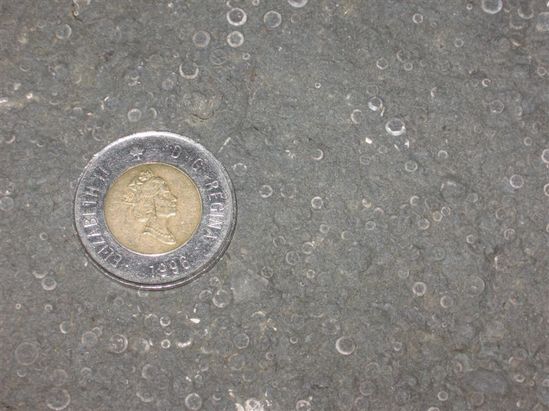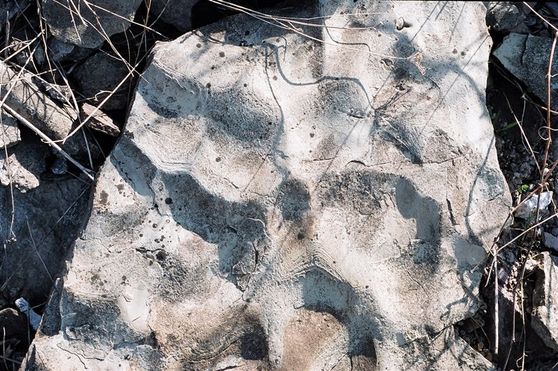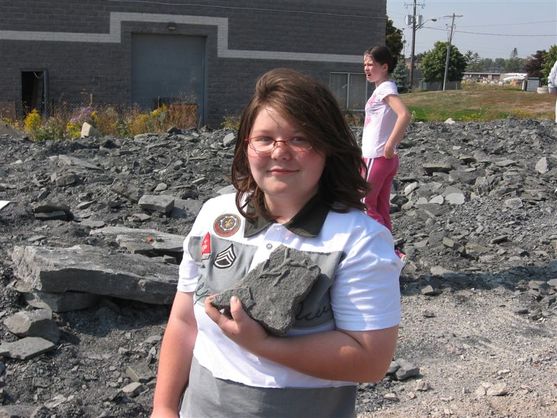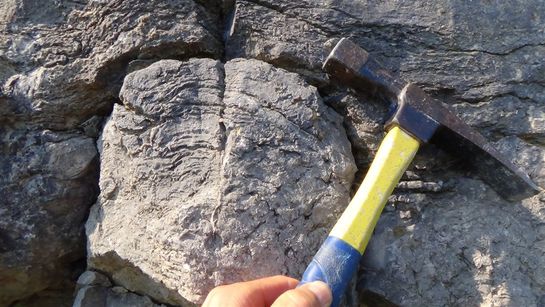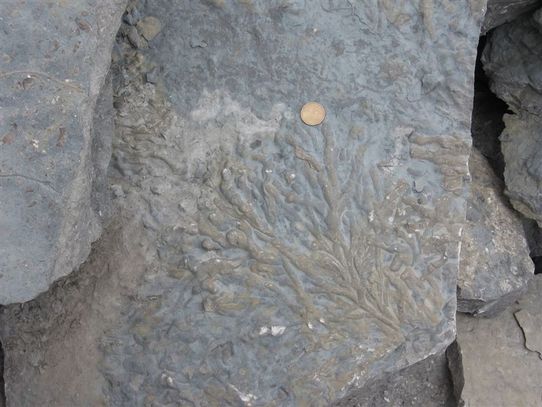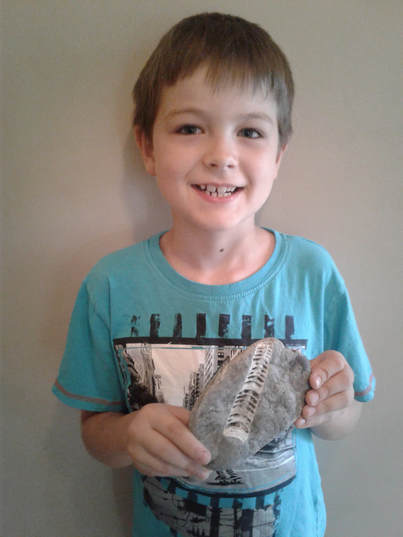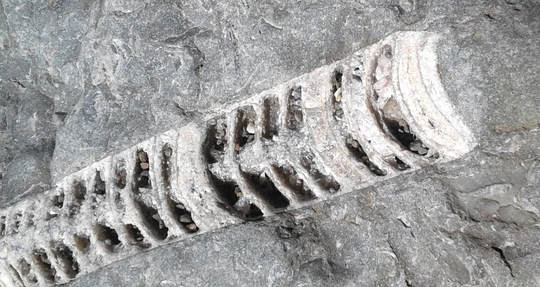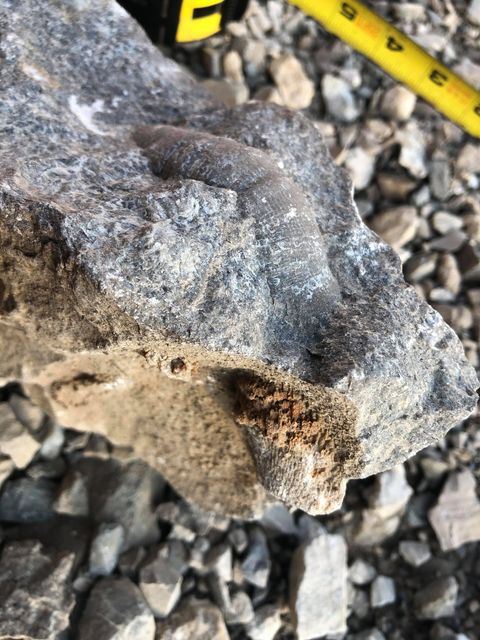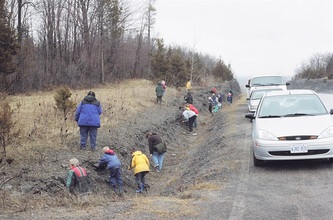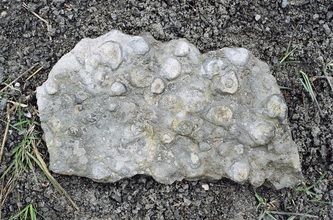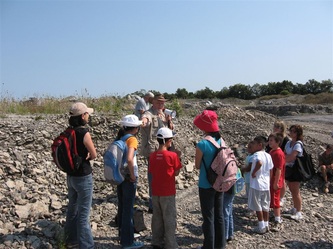Fossil Identification Web Page for Kids
We are fortunate to live in a Province that within a 2 hour drive radius we
have available a wide range of fossils and rocks to collect. They are located
on road cuts, river banks, shore lines, abandoned quarries, old construction
sites and anywhere rock is exposed.
Everyone has a few local fossils kicking around the house that they have collected
that are unidentified. Use this web page to locate what your fossil is and as help
in that school Geology project or as a guide for local fossil hunting.
Along with identification this web page provides evidence from that fossil
For Creation and Noah’s Flood using actual museum captions.
The bible overwhelmingly suggests that the earth is young therefore there
must be evidence for this. Since the bible is true there also must be
physical evidence for Creation and Noah’s flood. Fossils are a great way to
show your friends that all the evidence points to Creation and Noah’s flood and
not to evolution’s slow burial and millions and millions of years. The bible really
can be trusted. Many of the fossils pictured here were collected on our Creation
Research fossil trips and quarry research excursions. Interested in Creation Research
leading a fossil trip in your area?
You organize the group and we’ll organize the rocks!
Contact curator Martin Legemaate, [email protected]
We are fortunate to live in a Province that within a 2 hour drive radius we
have available a wide range of fossils and rocks to collect. They are located
on road cuts, river banks, shore lines, abandoned quarries, old construction
sites and anywhere rock is exposed.
Everyone has a few local fossils kicking around the house that they have collected
that are unidentified. Use this web page to locate what your fossil is and as help
in that school Geology project or as a guide for local fossil hunting.
Along with identification this web page provides evidence from that fossil
For Creation and Noah’s Flood using actual museum captions.
The bible overwhelmingly suggests that the earth is young therefore there
must be evidence for this. Since the bible is true there also must be
physical evidence for Creation and Noah’s flood. Fossils are a great way to
show your friends that all the evidence points to Creation and Noah’s flood and
not to evolution’s slow burial and millions and millions of years. The bible really
can be trusted. Many of the fossils pictured here were collected on our Creation
Research fossil trips and quarry research excursions. Interested in Creation Research
leading a fossil trip in your area?
You organize the group and we’ll organize the rocks!
Contact curator Martin Legemaate, [email protected]
A Creation Research fossil trip to Craigleith where construction piles
made for optimal fossil collecting.
made for optimal fossil collecting.
Trilobites
Description: Has the appearance of a small bug with ribs. Trilobites are on average about the size of a loonie.
Locations: All throughout Southern Ontario.
Hotspots: Craigleith, Belleville, Kingston. Many Ontario Creation Research fossil trips are conducted where
trilobites are prevalent.
Evidence: Intelligent design, Quick burial, Extinction.
Description: Has the appearance of a small bug with ribs. Trilobites are on average about the size of a loonie.
Locations: All throughout Southern Ontario.
Hotspots: Craigleith, Belleville, Kingston. Many Ontario Creation Research fossil trips are conducted where
trilobites are prevalent.
Evidence: Intelligent design, Quick burial, Extinction.
Carol Brandon has found an amazing trilobite fossil (Pseudogygities Latimarginatus)
There's Oil in Them Thar' Rocks!
Trilobite (Pseudogygites Latimarginatus)
The shale in Craigleith area contains oil. The trilobites were
buried quickly in such numbers that their body fats were
preserved and converted into oil. If plants and animals
died and were slowly covered there would be no oil in the
present world, yet there is oil suggesting a past catastrophic
worldwide flood like the one described in the bible,
Genesis 7: 18-20.
(Ref. Creation News Vol.8 No.4 )
Trilobite (Pseudogygites Latimarginatus)
The shale in Craigleith area contains oil. The trilobites were
buried quickly in such numbers that their body fats were
preserved and converted into oil. If plants and animals
died and were slowly covered there would be no oil in the
present world, yet there is oil suggesting a past catastrophic
worldwide flood like the one described in the bible,
Genesis 7: 18-20.
(Ref. Creation News Vol.8 No.4 )
Now in 3D!
Trilobite (Pseudogygites Latimarginatus)
Sarah Legemaate not only had a great time on a recent field trip, she also found the best trilobite.
It was 3 dimensional, which meant it had been buried alive, and the rocks it was in had been
deposited quickly.Trilobites are wonderful evidence life never began as simple organisms.
Thanks Sarah for the loan!
(Creation Research projects you can support Vol.16 No.3-2002 A.D.)
(Whitby Formation. Location: Craigleith Ont.)
Trilobite (Pseudogygites Latimarginatus)
Sarah Legemaate not only had a great time on a recent field trip, she also found the best trilobite.
It was 3 dimensional, which meant it had been buried alive, and the rocks it was in had been
deposited quickly.Trilobites are wonderful evidence life never began as simple organisms.
Thanks Sarah for the loan!
(Creation Research projects you can support Vol.16 No.3-2002 A.D.)
(Whitby Formation. Location: Craigleith Ont.)
Close up of Sarah's Trilobite
Eye Spy
Evolutionists claim life began as primitive forms which evolved into more
complex forms, however, trilobites had eyes not only with double lensing systems,
but they had Fresnal type lenses. It was Augustin Jean Fresnal who re-invented such
lenses for light houses - so we name them after their creator. But a trilobite had
Fresnel type lenses because it was programmed into their DNA which requires far
more creative genius than Fresnal. It also totally disproves the idea of a primitive
to complex sequence in the fossil record. The trilobites at the bottom have optical
systems as advanced as space age technology. The Trilobite, with its space age
“designer eyes”, can help you prove the point that God thought of it first!
(Ref. Creation News, 1999, Vol. 13 No. 1.)
Evolutionists claim life began as primitive forms which evolved into more
complex forms, however, trilobites had eyes not only with double lensing systems,
but they had Fresnal type lenses. It was Augustin Jean Fresnal who re-invented such
lenses for light houses - so we name them after their creator. But a trilobite had
Fresnel type lenses because it was programmed into their DNA which requires far
more creative genius than Fresnal. It also totally disproves the idea of a primitive
to complex sequence in the fossil record. The trilobites at the bottom have optical
systems as advanced as space age technology. The Trilobite, with its space age
“designer eyes”, can help you prove the point that God thought of it first!
(Ref. Creation News, 1999, Vol. 13 No. 1.)
Roll N’ Rock!
(Video clip may take a few seconds to load)
Like their land dwelling cousins today trilobites roll up when touched or frightened. This trilobite was found
rolled up indicating that a catastrophic event was about to befall it. The surrounding sediment solidified quickly
enough that it was unable to unroll after death.
(Ref. Creation News, 1998, Vol. 12 No. 1.)
(Trilobite Isotelus Matritzae, Lindsay Formation , Colborne Ont.)
(Video clip may take a few seconds to load)
Like their land dwelling cousins today trilobites roll up when touched or frightened. This trilobite was found
rolled up indicating that a catastrophic event was about to befall it. The surrounding sediment solidified quickly
enough that it was unable to unroll after death.
(Ref. Creation News, 1998, Vol. 12 No. 1.)
(Trilobite Isotelus Matritzae, Lindsay Formation , Colborne Ont.)
Crinoids (sea lilys)
Description: .Looks like long threaded bolts when laying down. Broken cross sections look like small discs.
Locations: All throughout Southern Ontario.
Hotspots: Niagara Escarpment
Evidence: Living fossil.
Description: .Looks like long threaded bolts when laying down. Broken cross sections look like small discs.
Locations: All throughout Southern Ontario.
Hotspots: Niagara Escarpment
Evidence: Living fossil.
Crinoid stems, Craigleith Ont.
Stuck in a Rut!
Crinoids or sea lilies are known as “living fossils” because they still live in the semi deep/deep part of the Pacific Ocean and
show no signs of evolving up to the present date. If they haven’t evolved after 400 million years, then they’re stuck in a rut!
The list of living fossils is growing and growing because they are still being found. Creatures really do produce after their own
kind just as Genesis says they do!
(Georgian Bay Formation Toronto Ont.) (Ref. Creation News Vol.17 No.3 -A.D.2003)
Crinoids or sea lilies are known as “living fossils” because they still live in the semi deep/deep part of the Pacific Ocean and
show no signs of evolving up to the present date. If they haven’t evolved after 400 million years, then they’re stuck in a rut!
The list of living fossils is growing and growing because they are still being found. Creatures really do produce after their own
kind just as Genesis says they do!
(Georgian Bay Formation Toronto Ont.) (Ref. Creation News Vol.17 No.3 -A.D.2003)
Broken crinoid stem cross sections (Georgian Bay Formation, Toronto Ont.)
Can you spot the crinoid stem all broken up? This is great evidence for a catastrophe.
(Walker Quarry, Ridgemount Ont.)
(Walker Quarry, Ridgemount Ont.)
Gastropods (sea snails)
Description: Coil shaped and spire shaped shells.
Locations: All throughout Southern Ontario.
Hotspots: Collingwood Ont..
Evidence: Living fossil.
Description: Coil shaped and spire shaped shells.
Locations: All throughout Southern Ontario.
Hotspots: Collingwood Ont..
Evidence: Living fossil.
David Weidelich came home from a fossil trip with a great gastropod specimen.
Look at that escargot!
Spired and coiled gastropods (sea snails) found along side modern gastropods.
no matter how many millions of years evolutionists say these fossils are, they
have produced after their own kind just as Genesis says they do!
(Lindsay formation, Collingwood Ont.)
Spired and coiled gastropods (sea snails) found along side modern gastropods.
no matter how many millions of years evolutionists say these fossils are, they
have produced after their own kind just as Genesis says they do!
(Lindsay formation, Collingwood Ont.)
An erosional surface revealing various gastropods.
Carden Quarry, Brechin Ont.
Carden Quarry, Brechin Ont.
Brachiopods
Description: A shell that is identical from the left side to the right side.
Locations: All throughout Southern Ontario.
Hotspots: Arkona and Hungry Hollow Ont,
Evidence: Well preserved, Extinction (less varieties today than in the rocks).
Description: A shell that is identical from the left side to the right side.
Locations: All throughout Southern Ontario.
Hotspots: Arkona and Hungry Hollow Ont,
Evidence: Well preserved, Extinction (less varieties today than in the rocks).
Two is Company............
Brachiopod (Mucrospirifer)
These specimens has been found among billions of other
well preserved fossils indicating rapid burial and large scale
flooding characteristic of Noah's flood as recorded in the bible.
(Location; Arkona / Hungry Hollow Ont.)
Brachiopod (Mucrospirifer)
These specimens has been found among billions of other
well preserved fossils indicating rapid burial and large scale
flooding characteristic of Noah's flood as recorded in the bible.
(Location; Arkona / Hungry Hollow Ont.)
Here Today, Gone Tomorrow!
Brachiopods are shells that are identical from left to right.
Thin shelled brachiopods in today’s waters can disintegrate after death
with in days to years say Taphonomists. (Taphnonmy is the study of the
process of decay and fossilization) If the fossil record formed slowly
taking hundreds of thousands of years to accumulate, you would expect
fragile shell material to be relatively uncommon.
(Answers Magazine Vol.2 No.2 2007)
(Georgian Bay Formation Toronto Ont.)
Brachiopods are shells that are identical from left to right.
Thin shelled brachiopods in today’s waters can disintegrate after death
with in days to years say Taphonomists. (Taphnonmy is the study of the
process of decay and fossilization) If the fossil record formed slowly
taking hundreds of thousands of years to accumulate, you would expect
fragile shell material to be relatively uncommon.
(Answers Magazine Vol.2 No.2 2007)
(Georgian Bay Formation Toronto Ont.)
Large brachiopods (Carden Quarry, Brechin Ont.)
Large brachiopods (Carden Quarry, Brechin Ont.)
Pelecypods (Clams, Mussels)
Description: A shell that is identical from the front side to the back side.
Locations: All throughout Southern Ontario.
Hotspots: Georgian Bay Formation, Niagara Escarpment.
Evidence: Quick burial, Living fossil
Description: A shell that is identical from the front side to the back side.
Locations: All throughout Southern Ontario.
Hotspots: Georgian Bay Formation, Niagara Escarpment.
Evidence: Quick burial, Living fossil
Yvonne Vanstemp discovers a fossil clam.
All Clammed Up!
Clams (Pelecypods) in the Lindsay Formation limestone were
found closed up.When you touch a modern living clam they close
up due to fright. When they die they open up. This means the fossil
clams were buried alive and deep that they couldn’t burrow out and
the surrounding sediments hardened too quickly for them to open up.
Special thanks to Yvonne Vanstemp for the loan of this specimen
found on a recent Creation Research field trip.
(Ref. Creation News Vol.17 No.3 A.D.2003)
Pelecypod
(A shell that is identical from front to back)
(Georgian Bay Formation Toronto Ont.)
(A shell that is identical from front to back)
(Georgian Bay Formation Toronto Ont.)
An abundance of mussels found in the Georgian Bay Formation. Toronto Ont.
Fossil Ripple Marks
Description: Looks like sand ripple marks.
Locations: All throughout Southern Ontario.
Hotspots: Georgian Bay Formation and Niagara Escarpment.
Evidence: Quick burial and quick hardening of sediments.
Description: Looks like sand ripple marks.
Locations: All throughout Southern Ontario.
Hotspots: Georgian Bay Formation and Niagara Escarpment.
Evidence: Quick burial and quick hardening of sediments.
John Mackay leading a fossil trip standing on giant fossilized waves of sediment. (Collingwood Ont.)
Catch a Wave!
One very common feature seen in many rock layers in many locations, is
the presence of “ripple marks” formed as water moves over a surface.
Ripple marks can be preserved only if they are quickly buried by overlaying
materials, so that they are protected and have time to turn in to rock. If such
a mark is exposed on any surface, markings will erode in a few decades.
There is no possibility that fragile features will last for millions of years.
Ripple marks point to an event of quick deposition such as the one year
long, world wide flood in Noah’s day.
(Niagara Whirlpool, Niagara Falls Ont.)
(Ref. The Young Earth, John D. Morris Pgs. 94,95.)
Ripple slab. Hamilton Ont.
Bryozoans
Description: Stick shaped and globular shaped usually with a dotted surface.
Also web and mound shaped.
Locations: All throughout Southern Ontario.
Hotspots: Georgian Bay Formation and Niagara Escarpment.
Evidence: Violent burial.
Description: Stick shaped and globular shaped usually with a dotted surface.
Also web and mound shaped.
Locations: All throughout Southern Ontario.
Hotspots: Georgian Bay Formation and Niagara Escarpment.
Evidence: Violent burial.
Caitlin Campbell locates a great branched bryozoan rock slab.
Bryozoan graveyard (Cape Crocker Ont.)
Royal Flush!
Modern bryozoans are common marine animals that
live in colonies similar to coral. The branched bryozoans in the
Georgian Bay Shale can be found broken up and dumped
in large deposits sandwiched between rock layers.
This is what you would expect to see as a result of a
watery catastrophe such as the Great Flood in Noah’s day.
Modern bryozoans are common marine animals that
live in colonies similar to coral. The branched bryozoans in the
Georgian Bay Shale can be found broken up and dumped
in large deposits sandwiched between rock layers.
This is what you would expect to see as a result of a
watery catastrophe such as the Great Flood in Noah’s day.
Bryozoans grow in several different shapes, branch, mound, bulbous and web shaped.
These globular shaped Bryozoans were not found in nice neat colonies but broken
off and fossilized in place. Many were found separated and broken in loose shale.
Further evidence of a watery catastrophe.
(Georgian Bay Formation Toronto Ont.)
Top view of a bryozoan colony. (Port Colborne Quarry)
Mound bryozoans (James Dick Quarry, Gamesbridge Ont,)
Webbed bryozoan, Whitby Formation Shale.
Eurypterid (sea scorpion)
Description: Looks similar to a lobster. Mostly found in pieces.
Locations: Lake Erie area.
Hotspots: Ridgemount Quarry.
Evidence: Extinct, Mixed with land plants.
Description: Looks similar to a lobster. Mostly found in pieces.
Locations: Lake Erie area.
Hotspots: Ridgemount Quarry.
Evidence: Extinct, Mixed with land plants.
Tiny eurypterid found by rock club member Peter Lee.
(Ridgemount Quarry, Ridgemount Ont.)
(Ridgemount Quarry, Ridgemount Ont.)
Vance Nelson discovers a eurypterid head on a research trip to Ridgemount Quarry.
What is a Eurypterid?
These are extinct marine arthropods and are classified
together with lobsters, crabs, etc. because they have an
Exoskeleton. They are found here in the Williamsville
Member and in Western New York State being part
of the “Buffalo Eurypterid Faunule”. In some areas
they are found mixed with land plants indicating a
catastrophic dump deposit.
“Some of the fresh water faunal and terrestrial
flora assemblages associated with eurypterid remains
may have been brought together by water action
(currents, floods, tides, etc.)” Page 8. Fossils of Ontario part 3:
The Eurypterids and Phyllocarids MJ. Copeland and Thomas E. Bolton
These are extinct marine arthropods and are classified
together with lobsters, crabs, etc. because they have an
Exoskeleton. They are found here in the Williamsville
Member and in Western New York State being part
of the “Buffalo Eurypterid Faunule”. In some areas
they are found mixed with land plants indicating a
catastrophic dump deposit.
“Some of the fresh water faunal and terrestrial
flora assemblages associated with eurypterid remains
may have been brought together by water action
(currents, floods, tides, etc.)” Page 8. Fossils of Ontario part 3:
The Eurypterids and Phyllocarids MJ. Copeland and Thomas E. Bolton
Tool Marks (bump skip and drag marks)
Description: markings resembling sticks or twigs.
Locations: Sparse areas in Southern Ontario.
Hotspots: Hamilton, Niagara Escarpment and where the Georgian Bay Formation is exposed.
Evidence: Fast flowing water.
Description: markings resembling sticks or twigs.
Locations: Sparse areas in Southern Ontario.
Hotspots: Hamilton, Niagara Escarpment and where the Georgian Bay Formation is exposed.
Evidence: Fast flowing water.
Miriam Legemaate showing the direction of water flow revealed in the tool marks.
Current Events!
These interesting structures are called tool marks or bump skip and
drag marks. Debris is dragged along by fast moving water marking
the sediment underneath. Eventually new sediment covers the marks
and creates a cast of the marks.The flow of water can be seen in the
larger slabs. This is great evidence for a catastrophe and not
for the slow and gradual processes of uniformitarian geology.
(Georgian Bay Formation Toronto Ont.)
These interesting structures are called tool marks or bump skip and
drag marks. Debris is dragged along by fast moving water marking
the sediment underneath. Eventually new sediment covers the marks
and creates a cast of the marks.The flow of water can be seen in the
larger slabs. This is great evidence for a catastrophe and not
for the slow and gradual processes of uniformitarian geology.
(Georgian Bay Formation Toronto Ont.)
Stromatoporoid
(Porous cousin to the stromatolite)
Description: Parallel wavy band pattern usually in circles.
Locations: Spotty areas in South Central Ontario.
Hotspots: Dundas and Buckhorn Quarries
Evidence: Extinct.
(Porous cousin to the stromatolite)
Description: Parallel wavy band pattern usually in circles.
Locations: Spotty areas in South Central Ontario.
Hotspots: Dundas and Buckhorn Quarries
Evidence: Extinct.
Daniel Gibson locates a stromatoporid specimen on a Creation Research fossil trip to Hamilton
Stromatoporoid, top view (Lafarge Quarry, Dundas Ont.)
Stromatoporoids are thought to be
closely related to corals or sponges.They are
common in the rocks of Ontario but are now extinct.
It’s another great example that we are losing species
not gaining, which is the opposite of evolution.
closely related to corals or sponges.They are
common in the rocks of Ontario but are now extinct.
It’s another great example that we are losing species
not gaining, which is the opposite of evolution.
Stromatoporoid (Buckhorn Quarry, Buckhorn Ont.)
Stromatolites
(Denser cousins to the stromatoporoid)
Description: Parallel wavy band pattern usually in circles.
Locations: Spotty areas in South Eastern Ontario.
Hotspots: Bath Ontario.
Evidence: Living fossil.
(Denser cousins to the stromatoporoid)
Description: Parallel wavy band pattern usually in circles.
Locations: Spotty areas in South Eastern Ontario.
Hotspots: Bath Ontario.
Evidence: Living fossil.
Stromatolite sandwich! Here is a section of strata just filled with them on a road cut in Bath Ontario.
Another prominent single specimen.
Stromatolites are considered by evolutionists to be one of the oldest organisms going back billions of years, however they are still living today. A famous colony exists in Shark Bay, Western Australia. Think about this, no matter how many billions of years old the evolutionists say these are, they have produced after their own kind just as Genesis says they do!
Worm Burrows
Description: Long tubular markings some are ribbed like modern earth worms .
Locations: sparse areas in Southern Ontario.
Hotspots: Grimsby and Brechin Ont.
Evidence: Well preserved.
Description: Long tubular markings some are ribbed like modern earth worms .
Locations: sparse areas in Southern Ontario.
Hotspots: Grimsby and Brechin Ont.
Evidence: Well preserved.
Fascinating fossilized worm burrows.
Grimsby Formation Balls Falls Ont.
Grimsby Formation Balls Falls Ont.
Overlaping fossilized worm burrows.
Grimsby Formation Balls Falls Ont.
Grimsby Formation Balls Falls Ont.
A large bedding plane consisting of worm burrows or Chondrites.
Chondrites are a complex system of worm feeding burrows. These are
regarded as feeding structures of sediment eating animals and are not
dwelling burrows.
Carden Quarry, Brechin Ont.
Chondrites are a complex system of worm feeding burrows. These are
regarded as feeding structures of sediment eating animals and are not
dwelling burrows.
Carden Quarry, Brechin Ont.
Graptolites
Description: Black sticks, some with toothed edges looking like combs or saw blades.
can also be web shaped.
Locations: Spotty throughout Southern Ontario.
Hotspots: Georgian Bay Formation and Craiglieth Ont..
Evidence: Extinct, Some are lined up to show a flow of water.
Description: Black sticks, some with toothed edges looking like combs or saw blades.
can also be web shaped.
Locations: Spotty throughout Southern Ontario.
Hotspots: Georgian Bay Formation and Craiglieth Ont..
Evidence: Extinct, Some are lined up to show a flow of water.
Cephalopods/Orthocones (Straight Coned Nautiloid)
Description: Long narrow cones with lines showing the chambers.
Locations: Spotty throughout Southern Ontario.
Hotspots: Belleville Buckhorn and Collingwood Ont..
Evidence: Many are lined up to show a flow of water, Intelligent design, Extinction.
Description: Long narrow cones with lines showing the chambers.
Locations: Spotty throughout Southern Ontario.
Hotspots: Belleville Buckhorn and Collingwood Ont..
Evidence: Many are lined up to show a flow of water, Intelligent design, Extinction.
A well preserved cephalopod found by Lauren Drader
Collingwood Ont.
Collingwood Ont.
Another great specimen found at Collingwood Ont.
A compressed specimen found in the Georgian Bay Formation, Toronto Ont.
A worn but amazing five foot cephalopod (endocreas) was found on the shale beach. Cephalopods
are squid like creatures some with straight coned shells. Unfortunately all Cephalopods except the curled
shelled Nautaloid are extinct. Most cephalopods on the beach were found pointing in a northwest/southeast
position showing there was a current involved in the burying of these creatures and that there was not a
"random fall to the bottom and bury" pattern as long age theory requires.
are squid like creatures some with straight coned shells. Unfortunately all Cephalopods except the curled
shelled Nautaloid are extinct. Most cephalopods on the beach were found pointing in a northwest/southeast
position showing there was a current involved in the burying of these creatures and that there was not a
"random fall to the bottom and bury" pattern as long age theory requires.
Lauren Drader's specimen was found pointing NW-SE
Also found pointing NW-SE was this cephalopod in Buckhorn Quarry, Buckhorn Ont.
Dozens of cephalopods found pointing NW-SE on the shore of Lake Ontario near Belleville hundreds of
kilometers away from Collingwood.
kilometers away from Collingwood.
Pointing the Way to the Flood!
Most of the cephalopods (straight coned Nautaloids) at these sites here were pointing in a NW-SE position.
They are all found in the same Simcoe Group of rock formations and are hundreds of kilometers apart. No
doubt a Province wide fast flowing water current was at work here.
Isn't this what you would expect to find if there were a large scale flood such as Noah’s Flood?
Most of the cephalopods (straight coned Nautaloids) at these sites here were pointing in a NW-SE position.
They are all found in the same Simcoe Group of rock formations and are hundreds of kilometers apart. No
doubt a Province wide fast flowing water current was at work here.
Isn't this what you would expect to find if there were a large scale flood such as Noah’s Flood?
Coiled Cephalopods and Ammonites
Description: Coiled shells some with lines showing the chambers.
Locations: Rare in Southern Ontario.
Hotspots: Arkona, Hungry Hollow Ont..
Evidence: Intelligent design, Extinction.
Description: Coiled shells some with lines showing the chambers.
Locations: Rare in Southern Ontario.
Hotspots: Arkona, Hungry Hollow Ont..
Evidence: Intelligent design, Extinction.
Whorled View!
Partial Coiled Cephalopod in Shale ("Trocholites ammonius")
Ammonites are related to the modern coiled Nautilus. The Nautiloid family is wonderful evidence
of God’s genius as the creator of the submarine. The present day Nautilus shell makes our human
submarines look amateurish. Sadly the present Nautilus family has only 3 members and all the ammonite
end of the family are now extinct. The world is losing animals, not gaining them. This is the opposite of evolution.
(Whitby Formation Bowmanville Ont.)
Ref. Creation News Vol. 15 No. 2, 2001 A.D.
Partial Coiled Cephalopod in Shale ("Trocholites ammonius")
Ammonites are related to the modern coiled Nautilus. The Nautiloid family is wonderful evidence
of God’s genius as the creator of the submarine. The present day Nautilus shell makes our human
submarines look amateurish. Sadly the present Nautilus family has only 3 members and all the ammonite
end of the family are now extinct. The world is losing animals, not gaining them. This is the opposite of evolution.
(Whitby Formation Bowmanville Ont.)
Ref. Creation News Vol. 15 No. 2, 2001 A.D.
Assorted pyritized ammonites found at Hungry Hollow Ont.
Photo courtesy of Peter Lee
Photo courtesy of Peter Lee
Coral
Description: Circular with lines radiating out from the center,
can also be cone shaped or branch shaped.
Locations: Common in Southern Ontario.
Hotspots: Arkona/Hungry Hollow
Evidence: Living fossil.
Coral, found in a boulder in Collingwood Ont. but the origin of the bolder is unknown.
Close up of coral, Buckhorn Quarry, Buckhorn Ont.
Rugose coral (Port Cobourne Ont).
Horn Coral (Hungry Hollow Ont.)
Conulariids
Description: Cone shaped with lines across it.
Locations: Common in Southern Ontario.
Hotspots: Craigleith Ont.
Evidence: Extinction, Quick burial.
Description: Cone shaped with lines across it.
Locations: Common in Southern Ontario.
Hotspots: Craigleith Ont.
Evidence: Extinction, Quick burial.
Shale slab with multiple specimens on it. Thanks to Andrew for the image.
Amazing conulariid fossil found by Andrew on a recent Creation Research fossil trip. Fenelon Falls Ont.
Conularia
are a poorly understood extinct group of cnidarians
thought to be closely related to jellyfish.
About 20 genera and 150 species are known as fossils.
Today they are extinct.
Ref; http://en.wikipedia.org/wiki/Conulariida
are a poorly understood extinct group of cnidarians
thought to be closely related to jellyfish.
About 20 genera and 150 species are known as fossils.
Today they are extinct.
Ref; http://en.wikipedia.org/wiki/Conulariida
Can't find your Ontario fossil here?
Then send a photo and a location of where it was found to: [email protected] or message us through our facebook page https://www.facebook.com/creationresearchmuseumontario and we will get back to you with an id and the evidence it provides for Creation, Catastrophe and Intelligent Design. Here are just a few examples of kids finally putting a name to a fossil!
Then send a photo and a location of where it was found to: [email protected] or message us through our facebook page https://www.facebook.com/creationresearchmuseumontario and we will get back to you with an id and the evidence it provides for Creation, Catastrophe and Intelligent Design. Here are just a few examples of kids finally putting a name to a fossil!
Matthew is one happy camper. He found a straight coned nautiloid on the beach near Stoney Creek Ont.
A bonus is that the fossil is worn down revealing fascinating chambers that the creature used for
buoyancy in water.
A bonus is that the fossil is worn down revealing fascinating chambers that the creature used for
buoyancy in water.
Close up of the chambers. Way to go Matthew!
Below is a typical discussion
Shannon:
Hi there! My kids found this fossil today at our farm in Hagersville. Do you have any idea what it could be?
Martin:
Ok I see them! I'll study them a bit and let you know!
Shannon:
Thank you! My kids would love to know what this could be 🙂 It’s kind of hard to see, but the “tube” kind of comes through the rock, and out the underside.
Hi there! My kids found this fossil today at our farm in Hagersville. Do you have any idea what it could be?
Martin:
Ok I see them! I'll study them a bit and let you know!
Shannon:
Thank you! My kids would love to know what this could be 🙂 It’s kind of hard to see, but the “tube” kind of comes through the rock, and out the underside.
Martin:
What a great find. This is a rugose coral. Yes your right it does extend through the rock and out the back. Coral is a living fossil producing after their own kind just as the bible says they do. However there are less varieties today than in the rocks. Loosing species is no help to the theory of evolution. We should be constantly gaining species if evolution were true. Your particular species of coral is extinct and is worthy of display. Congrats!
Shannon:
Wow! Thank you so much. I will talk with the kids about that. Thanks for that bit of info about evolution - that is a fantastic point! We are homeschooling this year, so I think we’ll use this to talk about creation (and how it differs from evolutionary theories). I so appreciate your help!
What a great find. This is a rugose coral. Yes your right it does extend through the rock and out the back. Coral is a living fossil producing after their own kind just as the bible says they do. However there are less varieties today than in the rocks. Loosing species is no help to the theory of evolution. We should be constantly gaining species if evolution were true. Your particular species of coral is extinct and is worthy of display. Congrats!
Shannon:
Wow! Thank you so much. I will talk with the kids about that. Thanks for that bit of info about evolution - that is a fantastic point! We are homeschooling this year, so I think we’ll use this to talk about creation (and how it differs from evolutionary theories). I so appreciate your help!
PHOTO GALLERY OF FOSSIL TRIPS IN THE BELLEVILLE AREA
(Click on the first photo and click the right arrow to advance)








